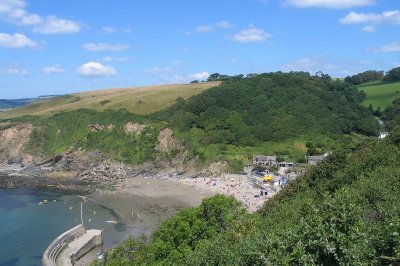


Former busy port now a quiet cove
Web: www.polkerrisbeach.com
Web: www.visitcornwall.com/destinations/polkerris
The tiny harbour hamlet of Polkerris stands on the eastern side of St. Austell Bay. It is reached from a lane off the A3082 between Par and Fowey. The village itself only consists of about twenty houses and a pub right on the beach, a restaurant and a water-sports centre based in the old fish store. Today, a picturesque place to spend time relaxing on and around the tiny beach but in former times Polkerris has been the scene for many a shipwreck including the 'Capitaine Remy' who was beached 300 yards off the coast here in 1920. It is also an area that is rife with tales of smugglers, the rocky coastline and narrow lanes made it ideal.
The hamlet and much of the land around is owned by the Rashleigh family, whose residence at nearby Menabilly was the Manderley of Daphne Du Maurier's novel, Rebecca. One of the Rashleigh family's most famous sons is the famous Cornish mineralogist, Philip Rashleigh III (1729-1811), whose stunning collections of Cornish minerals can be seen the Royal Cornwall Museum in Truro.
Polkerris had one of the largest fish cellars in Cornwall, so big that it was known as a fish palace. This is now The Rashleigh Inn. In the 1800's, Polkerris was a busy, thriving fishing port with over 200 people engaged in the task of curing and packing the pilchards. The pier was built in 1735 to shelter the fishing boats.
On the 26th August 1826 the ship 'Providence' was wrecked off Polkerris. The crew were saved by the lifeboat from Polkerris which was launched from the beach.
A lifeboat, the 'Catherine Rashleigh' was stationed in Polkerris in November 1859, and the boathouse was built for £138, on land donated by the Rashleigh's. The station transferred to Fowey in 1922 and the boathouse is currently a restaurant.
Nowadays the old chapel has been converted into a summer holiday let, the old life-boat house into a beach shop and 'take- away'. The Rashleigh Inn was previously the coastguard station and home, and the present car park for the pub was the site of the General Elliot public house, which was washed away by a fierce storm, as was a thatched cottage nearby. The last post office, in one of the cottage's kitchen, after running on a part-time basis for two years was finally closed in June 1990, through lack of use. The village school, opened in 1871 in part of the main pilchard cellar, closed in 1915.
Other points of interest include the lime kiln on the quay which was built by Philip Rashleigh in 1790 to burn limestone and produce lime for conditioning the soil for local farmers.
For those with their own canoes or kayaks, Polkerris makes an excellent base for exploring the beautiful rocky shoreline towards Gribbin Head with all the spectacular inlets and caves.
Gribbin Head between Par and Fowey, is 250 feet high, owned by the National Trust, and topped by an 84 foot high day marker built in 1832 to guide ships into Fowey. Wonderful walking along the coast path with impressive views. Menabilly, the family home of the Rashleigh's, and once home to Daphne Du Maurier is nearby.
Daphne Du Maurier (1907-1989) has lived at two nearby houses, Menabilly and Kilmarth which are both part of the Rashleigh Estate owned by the Rashleigh family and both only about a mile away.
Charlestown Fowey Gribbin Head Par St. Austell The Eden Project Tywardreath
The Coastal Footpath